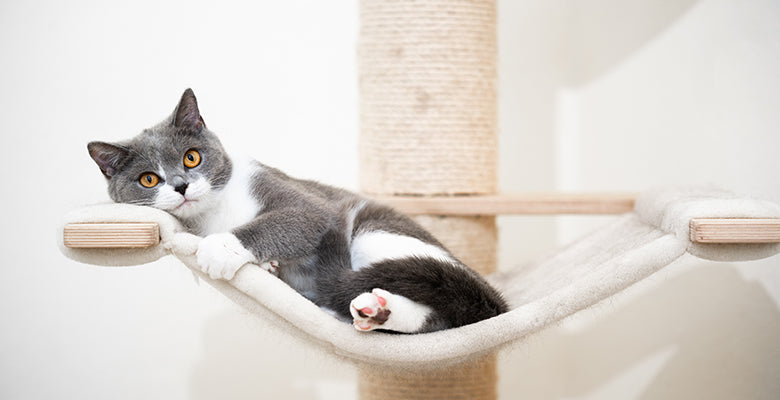One of the quintessential purchases you will make for your feline best friend is a cat tree. Tall and full of holes, hides and scratching posts, cat tress help satisfy your cat’s natural instincts to climb, perch and scratch without taking it out on your household furniture. But we’ve all experienced the sting of rejection – when you buy something nice for your pet and they’d rather play with the box while their brand-new castle sits collecting dust. Can you avoid making the wrong purchase, or is there no overcoming picky paws?
i.Pet is here to give you some smart tips on finding the right cat tress for your home!

Know the behaviour of your cat.
Does your cat love cuddling up to your soft jumpers, or do they constantly scratch at anything in reach? Are they young and spry, or old and sleepy? Are they extroverted and love hanging out with you or do they prefer to sit in boxes? You know your cat better than anyone, and you should take into account their preferences when buying a tree – things like their favourite materials, hides, scratching positions, and toys. You also need to take into account their age and health conditions: an older cat may need a lower tree, while the higher the better for a kitten.
Is it suitable for your cat’s size?
A small tabby kitten and an adult forest cat will need vastly different things in their cat trees. Aside from making sure it will hold your cat’s weight, you want to make sure things like hides, hammocks and perches are big enough for them to comfortably sit or snuggle.

Get sturdy construction.
You need a cat tree with a sturdy, wide base to make sure the tree won’t tip over. It should be made from strong and durable materials – a tree is an investment after all. When it comes home, consider putting it against a wall and definitely place it on a clear, flat surface.
Use claw friendly surfaces - must have scratching post.
There’s no doubt about it, your cat tree needs a scratching post. For one thing it protects your home from wandering claws – for another it’s necessary for the cat to be able to scratch in a safe place. For best results, buy a cat tree that has claw friendly materials such as sisal rope, corrugated cardboard and carpet, as well as soft places.

Make sure your tree is non-toxic.
Avoid pet trees that may have used/had contact with the following chemicals:
- Lead
- Formaldehyde
- Arsenic
- Bromine
- Phthalates
- BPA
The severity of symptoms may vary, but all of these are not great for your feline friend to encounter or risk swallowing. Choose cat trees made from pet-friendly, non-toxic materials.
Even if you are 100% certain about the quality of your tree, observe your cat’s interactions with the tree for the first week or so – it may turn out they are allergic to something!
A tree per cat.
Some cats are good at sharing. Some are territorial bullies who won’t even share their air. If you have more than one cat, consider getting more than one cat tree too. Avoid sibling rivalry and keep everyone relaxed with their own space.

i.Pet has an extensive range of sturdy, non-toxic cat trees just for your furry family. Available in every considerable size, shape, colour and configuration, you’ll be sure to find one that is perfect for your home aesthetic as well as for your cat. Shop the range today from any one of our retail partners.